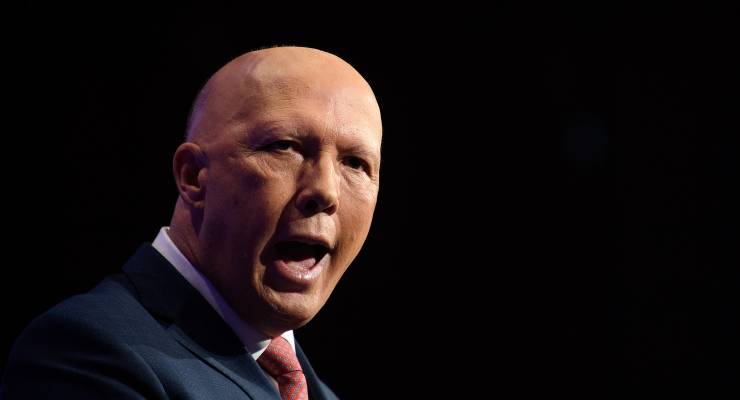
In his budget reply speech, Opposition Leader Peter Dutton twice warned that Australia’s population could grow by 1.5 million over the next five years, “the highest number in our country’s history and more than the population of Adelaide”.
It’s a scare campaign aimed at voters anxious about the housing market: where will all these people live? But given the Coalition’s record, Dutton’s divisive tactics are hypocritical and cynical. If Labor is going down the path to a Big Australia, then so was the previous government.
Dutton’s numbers are accurate. Net overseas migration (NOM) measures the overall increase (or decrease) in population resulting from long-term arrivals and departures and it will hit a record high of 400,000 this financial year.
The budget papers project NOM at 315,000 next year. But this is catch-up, because for the past three years COVID-19 pushed migration way below trend. From 2024-25, NOM is expected to stabilise at 260,000 people a year. That’s the same annual level predicted over five years in the 2019 budget when Dutton was responsible for immigration.
So the Coalition was also going to add an extra “Adelaide” to the population. Thanks to the pandemic, we’re getting it later than anticipated.
This is cold comfort to families desperate to find somewhere affordable to live after the landlord just raised their rent. The return of international students, backpackers and skilled migrants is sharpening competition for tenancies, especially at the affordable end of the market.
But Australia’s rental market was in crisis long before border controls were lifted, and the Coalition failed to act. It ignored the plight of tenants and focused all its attention on spruiking home ownership. Yet its policies contributed to an extended price boom that made housing even less affordable for first-time buyers.
The Coalition’s line was that escalating real estate prices were caused by a lack of supply because local planning and zoning rules prevented developers from building. Its then-housing minister Michael Sukkar said it was the job of state and territory governments — not Canberra — to ensure that “supply of new housing can keep up with demand”.
An adequate pipeline of new construction is essential to a well-functioning housing market, but the “not enough building” argument doesn’t give the full picture. In a speech a year ago, assistant Reserve Bank governor Luci Ellis said it was likely housing supply had been running ahead of anticipated demand for a number of years.
She backed this with a chart that showed the growth in dwelling stock exceeding population growth for much of the past 30 years. The chart also shows the sudden drop in population growth caused by the pandemic, which Ellis estimated resulted in up to 200,000 fewer households than expected arriving in Australia.

The pandemic was a natural experiment. According to the Coalition’s “not enough supply” theory, closed borders should have cut demand for housing and pushed down prices. Yet the opposite happened. Prices skyrocketed.
Ellis thought the homes that would have been occupied by the missing 200,000 households were instead taken up by locals who could afford to pay for more room.
“Spurred by the experience of lockdown and self-isolation many people understandably wanted a bit more space, and perhaps a garden,” she said. “Some also needed space where they could work, or perhaps just fewer flatmates to share that space with.”
This shows that population growth is not the only driver of house prices. Demand doesn’t only come from extra households, British housing economist Professor Geoff Meen writes. It also comes from “existing households as incomes rise”.
With more wealth, people want bigger dwellings, second homes and holiday houses. As the rich get richer they consume more housing, driving up prices. The poor, meanwhile, consume less, to the point of severe overcrowding or homelessness.
The 2021 census shows that 12.5% of homes in Australia have three or more spare bedrooms, meaning a lot of housing is underutilised.
The supply of housing matters, but so does its distribution. If property was taxed differently, housing might be used more efficiently and fairly.
Labor shows no interest in reopening that debate, but at least it’s doing something to assist tenants pushed into poverty by housing costs. It increased rent assistance in the budget, and its $10 billion housing Australia future fund promises 30,000 homes for low-income earners.
The Greens rightly argue that is far from enough and demand a much bigger investment. But the Coalition opposes the fund outright. If Dutton was serious about planning to “sensibly manage migration”, he’d be pushing Labor to make a bigger investment too.








The Leader of the Opposition is nothing, if not predictable. His impotent exclamations and hyper charged language are just cut and paste pieces from his past hits.
An ex copper from Queensland who talks exactly like a copper from Queensland.
Much more of a bad cop than a good cop. He is a humourless Trumpian monster and just as mendacious.
Peter Dutton, friend of the homeless. Why am I finding that hard to swallow?
Yep, come to me and I’ll empty your bank account quick smart… won’t complete that sentence but you can all probably know the next bit.?
I remember Dutton’s earlier “solution” to housing affordability was to allow people to withdraw their super to escalate the bid process. No extra people would’ve been able to buy their own home, but the less well off would become even less well off by also emptying out their superannuation – as the additional money available to buyers pumps prices even higher.
any opposition is predictable and so was Albanese when he was opposition.
Dutton was part of a 9 year Coalition Government that raised the Immigration ceiling 3 times, and di nothing to increase Housing.
He is proving to be a bigger Hypocrite than a lot of people thought.
He is just as toxic as Morrison and racist Hanson. They all like punching down.
Dutton is dealing with the consequences of the LNPs strategy of having no actual policy for their term in government. It means that Dutton is being caught out when he attempts to challenge Labor, they just need to point at their decade of incompetence to win the argument.
Dog Whistle Dutton and governments of which he was a part have miserably mismanaged migration at just about every level. Whether it is stacking the AAT or allowing the pile up of people in the system with bridging visas or linking study to migration to attract international students to Australia without offering sufficient migration places or creating an army of exploitable temporary residents without pathways to permanence the list goes or having continual schizoid changes to the rules the list of incompetencies goes on and on.
Perhaps if he had not wasted $80 million on consultants for advice on how to privatise visa processing and spent this money encouraging the Department of Home Affairs to process applications expeditiously in accordance with the law instead of like cowboys in the wild west the situation would not be so dire.
Now he suddenly wants to talk about a big Australia, as if the hordes of temporary residents he allowed in do not consume housing and other services and it is only the permanent migrants who do.
Dog Whistle Dutton can only thrive because the media is ignorant about the realities of the migration program.
It’s not a $10b housing fund.
It’s a $10b financial services feeding trough with a $500m/yr (best case) house building side gig.
30,000 homes over 5 years.
6,000 homes each year; BUT
That’s assuming – best case – homes can be built for ~$83k each.
So in reality it will be more like 1,000 – 2,000 homes per year (again, BEST CASE). Which couldn’t even soak up 2% of the NOM.
Calling it comically inadequate, would be far too generous.
And this isn’t even thinking about all the other stuff that needs to be built – infrastructure, schools, hospitals, etc, etc.
The way I understood it a future fund increases through interest on the capital, so depending on interest rates $10B could have a nice pot in it’s first year, if the capital is able to have no dipping into it the increase each year should allow for more per house than you claim. Tnis isn’t a bad idea when you look at how much can be accumulated even daily.
The housing fund can disburse a maximum of $500m per year (and even that at the Minister’s discretion).
So, if it makes enough return after the fund managers have taken their cut, to have $500m spare, then the Minister can decide (but is not required) to spend that on housing.
If it doesn’t make the necessary profit to have the full $500m to spare then, subject to the same discretion, that lower amount can be used.
If it doesn’t make enough profit to have anything spare, then nothing will be spent that year.